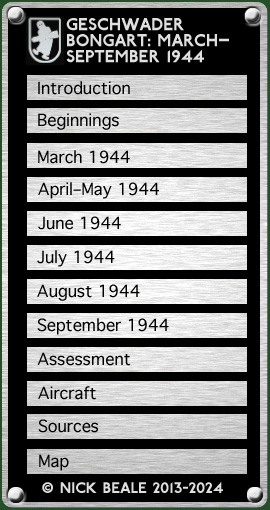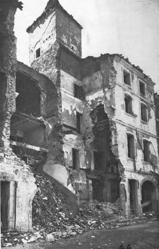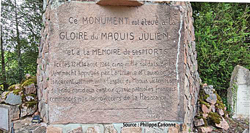|
At 07.30 hrs. the 6./KG 26 was ordered to dispatch three Ju 88 at noon against “terrorists” in Séderon, 95 km south east of Valence. The three bombers began by making three passes at rooftop height, causing confusion among the 500 or so villagers until a Gendarme managed to urge many into shelter. The first aircraft opened machine gun fire and dropped two bombs, the first of which wrecked the village abattoir. Detonating near the river, the second destroyed a footbridge, killing two women crossing it. Another woman was killed by a bullet and two more people wounded. Smoke now covered the village and “The Tower”, a tall rock, forcing the next Junkers to come in at a more cautious altitude. Apparently unable to see much, the aircraft made an inaccurate release and both SC 500 were duds but the last plane dropped AB canisters, the bomblets causing further deaths and injuries. All this took just 10 minutes. Six civilian deaths are commemorated on the village’s war memorial; Robert Serre refers also to three Maquis casualties on the village outskirts, one of whom died of his wounds in hospital. In Vanosc, a Ju 88 dropped containers of anti-personnel bombs which wounded 25 French people and five members of OSS Operations Group BETSY. Most of the injured were evacuated to the hospital at Saint Agrève but Sgt. Camille A. Barnabe, wounded in the abdomen, died there. The Americans had sought cover in an orchard when the alert was given and material damage in the village seems to have been limited to broken windows in the church and houses. French sources say this Ju 88 was from Valence (about 45 km away to the SE). Since II./KG 26 was operating against the Maquis that day they were probably correct. South east of Grenoble, aircraft strafed Maquisards at L’Alpe d’Huez. 11 August Main effort of guerilla activity continues to lie in sabotaging railways and trunk cables. Increasing tension and increasing number of surprise attacks on occupying troops. A large-scale action is expected in southern France in the next few days … Several successful operations have been carried out in southern France. The Vercors operation has so far yielded the following results: 1031 partisans killed, 288 taken prisoner. Luftflotte 3 situation reports According to Abwehr station report, orders for enemy actions in Haute Savoie, Savoie and Isère have been issued. Security Service Vichy reports that a concentric attack against Clermont-Ferrnad is imminent. Both reports are probably connected with the new strong supply incursions and battle events in the north. Privas has been attacked since early this morning by strong forces. Town area of Lyons is at present quiet. Military Commander France Luftflotte 3 relayed an OKL order of the day before, decreeing a “further, considerably greater reduction” of all flying because of the damage done to fuel production by Allied bombing. A Ju 88 sent by the Geschwader to reconnoitre Privas saw German troops’ cloth recognition panels laid out on the market square. Road blocks had been removed and fighting appeared to have ceased. Reinforcing the impression of relative tranquility, a Go 145 up to look for parachute drops reported in the Haute-Loire Département could find no trace of them. The II./KG 26 was also active against French villages, six of its Ju 88s flying 13 sorties between 14.40 and 18.50 hrs. The unit’s targets included Cruseilles (Haute-Savoie), Entrevaux (45 km north west of Nice) and Lyas and Ajoux (both in the Ardèche).
The hamlet of La Douzette, 108 km north east of Clermont-Ferrand, was home to around 40 people and does not appear to have been a centre of Maquis activity. On the afternoon of 11 August the sound of an engine brought people from their houses to see a plane circling low overhead. It dropped one bomb, hitting a barn and killing five people inside. Six died in all, livestock were killed and houses were wrecked. A battle was fought around Cluny (135 km north east of Clermont) after the Resistance barred an important road junction and a railway tunnel. The Germans despatched troops, variously estimated between 500 and 2000 strong, from Mâcon to recapture the town and restore lines of communication. At 06.30 GMT three fighter bombers bombed the town and then spent 30 minutes shooting up the Col du Bois Clair from which the Résistants could command the Mâcon–Cluny road. This strafing drove the French deeper into the woods, allowing the attackers to retake the crossroads. The defenders launched a successful counterattack that afternoon and at 15.00 hrs. five twin-engined aircraft weighed in to assist the Germans’ disengagement, machine gunning the roadsides before going on to bomb the town. Thirteen people were killed in the bombardment and 97 buildings were destroyed or damaged but the Germans gave up and Cluny became the first liberated town in the Saône-et-Loire Départment. 12 August Unternehmen Hochsommer (Midsummer) was now underway, a push against the l’Oisans Maquis and during the day an observation plane, “painted in red”, persistently flew over the positions of their Mobile Group Nº 3. The Geschwader put up three Ju 88 and six Re. 2002 on five operations in support of the 157. Reserve Division south east of Grenoble. they bombed Allemont and Le Bourg D’Oisans, wrecking many houses and causing “heavy casualties to the terrorists.” The latter village was circled by an aircraft at 17.30 (local time) and two 250 kg bombs fell in the centre, wrecking four buildings but causing no deaths or injuries. Also that evening, what was thought to be a Ju 88 bombed the valley of l’eau d’Olle. Over in the west, two He 46 and a Ju 88 flew individual reconnaissance sorties for LXVI. Korps between Ussel and Tulle in support of three German companies penned in a road tunnel 9 km west of Murat (at Le Lioran). They had arrived there the previous afternoon after withdrawing from Aurillac as part of a regroupment. Two Ju 88 were then dispatched to bomb the besieging Résistants’ positions, claiming to have caused heavy casualties. From Jesser the message went out late in the afternoon to »Myrtenkranz« (myrtle wreath) that the Luftwaffe would be attacking the tunnel’s northern exit at a time to be advised. The besieged group was to break out northward during that attack, firing while flares to indicate their own positions and red to point out the enemy’s. At around 02.00 (local time) “five twin-engined aircraft" shot up the camp of the Maquis Mariaux group at Crux-la-Ville, about 85 km east of Bourges, as the prelude to an infantry assault. A four-day series of engagements ensued, ending in the Résistants’ withdrawal. A Mariaux fighter, Henri Joly, later recalled: First we fought in the Nevers area … then to the eastern parts of our region, towards Morvan, trying to stop the German convoys withdrawing towards Eastern France. At the begining of August 1944, we received the order to help comrades in arms knowing that German were gathering many forces in their aera. Our camp of Résistants was hidden in the forests near Crux-la-Ville. There, we were attacked several times by strong German troops and by little German aircraft. Really, it was very impressive. They strafed and bombed … I remember their strafing very well … We were suroundered by blue flames when bullets hit the ground … What a hell! Citing an order from Luftflotte 3, Westa 2 Ob.d.L. was told to equip all its aircraft “with the means available in the area where they are stationed” so that they that they could be used to bomb guerilla camps or to supply German forces surrounded by Resistance groups. continued on next page …
|
|||||



